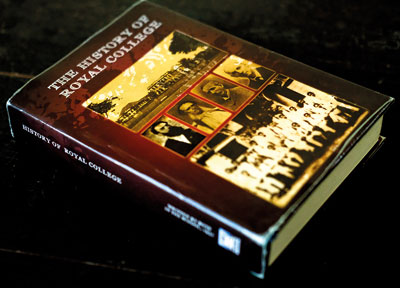Sunday Times 2
Through the mists of time emerges the portrait of a school and Ceylon’s colonial society
A faded print of a group of young men adorns the burgundy jacket of The History of Royal College. They stand under Gothic arches with a patina of ivy. These are the young authors of the book- 20 young Royalists who produced between them the first biography of the school in 1931.
 In the attempt, they unwittingly tipped into the cauldron, along with the facts and anecdotes, the ethos of the public schoolboy- a tradition that was still alive in the Interwar years wherever in the British Empire. Between the lines you will glimpse at least some of these habits entrenched in lofty stone corridors: a love for cricket, pugnacity, name calling (and name dropping), no privacy among fellows and silly songs. Yet this book also manages to stand- even today- as a highly competent history of Royal.
In the attempt, they unwittingly tipped into the cauldron, along with the facts and anecdotes, the ethos of the public schoolboy- a tradition that was still alive in the Interwar years wherever in the British Empire. Between the lines you will glimpse at least some of these habits entrenched in lofty stone corridors: a love for cricket, pugnacity, name calling (and name dropping), no privacy among fellows and silly songs. Yet this book also manages to stand- even today- as a highly competent history of Royal.
The school has now brought this volume out of oblivion with a second edition.
Twenty students, aged 15 to 19, were the original writers. The roll call incidentally included G. P. (Pieter) Keuneman. The rest of the boy scribes who joined the ranks were L. A. Goonewardene, P. E. Weeraman, B.A. Kuruppu, P.T. Kuruppu, D. A. Herat, A. B. Perera, R. N. Ilangakoon, H. W. Jayewardene, A. S. Wimalakirti, A. C. Ebell, E.S. Amerasinghe, N.F. Gunesekera, R. Prasad, D. M. Perera, R. T. Ratnatunga, F.R. De Saram, A.L. Gunasekera, A.S. Outschoorn and W.T. M. Wimalaratne.
The supervisors were two history masters and two classics masters- to balance accuracy and perspective with (one assumes) style and elegance.
But the work soon went out of print. It remained only in some die-hard Royalists’ collections (including that of the Wickremesinghes: Esmond, late father of the current Prime Minister, kept a copy).
The new edition was resurrected by Senaka Weeraratna, and the Royal College 1960 Group. The fellow members of the 60 Group who made up the core project team were Dr. Ajita Wijesundere and Vajira Gunawardana. The book comes in the old print, as if fresh off the press of H. W. Cave and Company, Slave Island.
The preface, by the then Principal H. L. Reed, has this quaint caveat:
“It is hoped that literary style is altogether absent. Boys of this age should have no literary style, and these boys particularly have been sedulously advised to avoid all artificialities of diction.”
This stipulation- meant to check schoolboy gushing- keeps things pithy.
Though we are dealing with the history of a colonial public school- a matter of academia, wooden desks, solemn halls and track and field- in short dead of colour and imagination- the work is readable. The style is consistent (the chief editor was Reed himself- no inelegant wielder of language) and the language crisp and smart.
It is a story leavened with humour- a dry British Interwar humour of anecdotage.
Once ‘a very dull boy’ was asked by the classics master (Todd) if he has “got his Prometheus Bound?” The boy replied No, but that he had given “it to Baron Singho of the Pettah to be bound.
““Do you think Baron Singho could bind Prometheus?” asked Todd in his quiet manner. “Oh yes sir, easily,” said the dull boy. Todd shut his eyes, and went into a reverie… The dull boy left school immediately after and became a most estimable Mudaliyar.”
This is no mere glorification of the school- the warts have not been doctored, and that is rather touching.
The history begins with a sweeping chapter entitled Education in Ceylon before the Time of Royal College. From the second chapter it goes on to give a thickly detailed account of the school itself- from 1835 to 1931. It charts the saga of the private school called Hill Street Academy till it became Royal College- following the whiff of fashionable Colombo from the Pettah to Hulftsdorp, Thurstan Road to Reid Avenue- from a Church back verandah to majestic quadrangles.
Though literary style was banned, the authors are not above weaving in some pictorial detail- of the wild Royal-Thomian, or other school traditions- with often a hint of schoolboy impishness. It is not dry-as-dust, Oxford History of England- history.
It is an invaluable work- showing how Royal as a fledging tested its wings tentatively before going on to establish a proud tradition as an Anglican become secular public school- commanding the highest adulation.
It offers, too, a glimpse into colonial society where the Sinhalese, the Tamils and the Muslims, mixed with the Burghers, the Malays, the Parsis and the English- a rich social fabric, which, for the great part, was actually woven at Royal itself.
This facsimile edition of The History of Royal College is a Vijitha Yapa publication priced at Rs.2,990 and available at all Vijitha Yapa bookshops.

